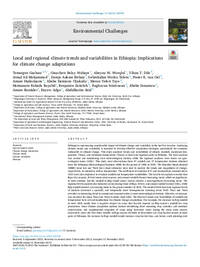Local and regional climate trends and variabilities in Ethiopia: Implications for climate change adaptations

Authors:
Ethiopia is experiencing considerable impact of climate change and variability in the last five decades. Analyzing climate trends and variability is essential to develop effective adaptation strategies, particularly for countries vulnerable to climate change. This study analyzed trends and variabilities of climate (rainfall, maximum temperature (Tmax), and minimum temperature (Tmin)) at local and regional scales in Ethiopia. The local analysis was carried out considering each meteorological station, while the regional analyses were based on agroecological zones (AEZs). This study used observations from 47 rainfall and 37 temperature stations obtained from the Ethiopian Meteorological Institute (EMI) for the period of 1986 to 2020. The Modified Mann-Kendall (MMK) trend test and Theil Sen’s slope estimator were used to analyze the trends and magnitudes of change, respectively, in rainfall as well as temperature. The coefficient of variation (CV) and standardized anomaly index (SAI) were also employed to evaluate rainfall and temperature variabilities. The local level analysis revealed that Bega (dry season), Kiremt (main rainy season), and annual rainfall showed increasing trend, albeit no significant, in most stations, but the rainfall in Belg (small rainy) season showed a non-significant decreasing trend. The regional levels analysis also indicated an increasing trend of Bega, Kiremt, and annual rainfall in most AEZs, while Belg rainfall showed a decreasing trend in the greater number of AEZs. The result of both local and regional levels of analysis discerned a spatially and temporally more homogeneous warming trend. Both Tmax and Tmin revealed an increasing trend in annual and seasonal scales at most meteorological stations. Likewise, an increase was recorded for mean Tmax and Tmin in entire/most AEZs. The observed trends and variabilities of rainfall and temperature have several implications for climate change adaptations. For example, the decrease in Belg rainfall in most AEZs would have a negative impact on areas that heavily depend on Belg season’s rainfall for crop production. Some climate adaptation options include identifying short maturing crop varieties, soil moisture conservation, and supplemental irrigation of crops using harvested water during the main rainy season.
Conversely, since the first three months of Bega season (October to December) are crop harvest season in most parts of Ethiopia, the increase in Bega rainfall would increase crop harvest loss, and hence, early planting date and identifying short maturing crops during the main rainy season are some climate adaptation strategies.
Because of the increase in temperature, water demand for irrigation during Bega season will increase due to increased evapotranspiration. On the other hand, the increase in Kiremt rainfall can be harvested and used for supplemental irrigation during Bega as well as the small rainy season, particularly for early planting. In view of these findings, it is imperative to develop and implement effective climate-smart agricultural strategies specific to each agro-ecological zone (AEZ) to adapt to rainfall and temperature changes and variabilities.
